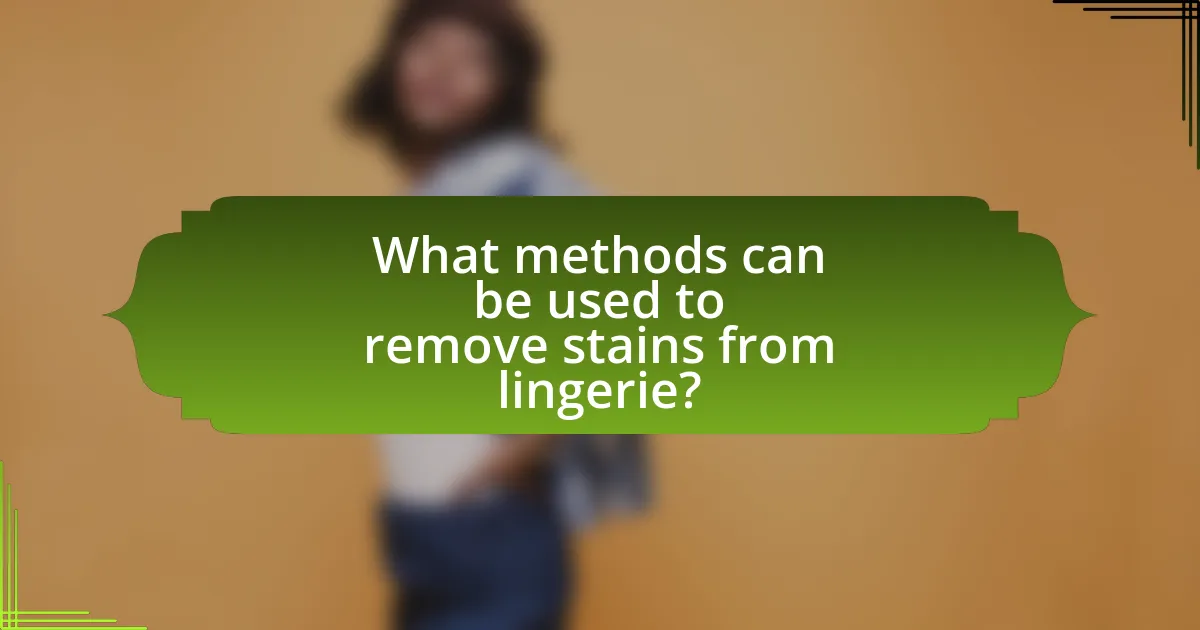The article focuses on effective methods for removing stains from lingerie without causing damage. It identifies common types of stains, such as bodily fluids and food spills, and discusses how different stains affect various lingerie fabrics. The article emphasizes the importance of prompt stain treatment to prevent permanent discoloration and fabric degradation. It outlines appropriate cleaning methods for different stain types, the benefits of natural versus commercial stain removers, and best practices for maintaining lingerie post-cleaning. Additionally, it provides troubleshooting tips for stubborn stains and lingering odors, ensuring the longevity and integrity of delicate fabrics.

What are the common types of stains on lingerie?
Common types of stains on lingerie include bodily fluids, such as menstrual blood and sweat, as well as food and drink spills, like wine or chocolate. These stains can vary in difficulty to remove depending on the fabric and the age of the stain. For instance, menstrual blood can be particularly challenging if not treated promptly, while sweat stains may lead to discoloration over time. Understanding these common stains is essential for effective cleaning and maintenance of lingerie.
How do different stains affect lingerie fabrics?
Different stains can significantly affect lingerie fabrics by causing discoloration, weakening fibers, and altering texture. For instance, oil-based stains, such as those from lotions or cooking oils, can penetrate delicate fabrics like silk and lace, leading to permanent marks if not treated promptly. Similarly, protein-based stains, such as blood or sweat, can cause fabric degradation over time due to their chemical composition, which can break down fibers. Additionally, dye stains from colored foods or beverages can lead to color bleeding, especially in lighter fabrics, making them appear dull or uneven. Immediate and appropriate stain removal techniques are crucial to minimize these effects and preserve the integrity of lingerie fabrics.
What are the characteristics of oil-based stains?
Oil-based stains are characterized by their ability to penetrate porous surfaces and create a durable, long-lasting finish. These stains typically have a thicker consistency compared to water-based stains, which allows them to adhere better to surfaces and resist fading over time. Additionally, oil-based stains often require longer drying times, usually ranging from 6 to 24 hours, depending on environmental conditions. Their formulation includes pigments suspended in oil, which enhances color richness and depth. Furthermore, oil-based stains are less prone to water damage, making them suitable for high-moisture areas.
How do protein-based stains differ from dye stains?
Protein-based stains, such as those from bodily fluids or food, differ from dye stains, which are caused by pigments or colorants. Protein-based stains require enzymatic or protein-dissolving treatments for effective removal, as they are organic and can bond with fabric fibers. In contrast, dye stains often necessitate color removal techniques or specific solvents that target the dye molecules, as they are typically synthetic or natural colorants that adhere to the fabric differently. This distinction is crucial for selecting appropriate stain removal methods to avoid damaging delicate lingerie fabrics.
Why is it important to treat stains promptly?
It is important to treat stains promptly because immediate action prevents the stain from setting and becoming more difficult to remove. Stains, if left untreated, can penetrate the fabric fibers, making them more stubborn and potentially leading to permanent discoloration. For example, studies show that treating a stain within 24 hours significantly increases the likelihood of complete removal compared to waiting longer.
What are the consequences of leaving stains untreated?
Leaving stains untreated can lead to permanent discoloration and damage to the fabric. Over time, stains can set into the fibers, making them increasingly difficult to remove and potentially weakening the material. For instance, organic stains like food or sweat can attract bacteria, resulting in unpleasant odors and further degradation of the fabric. Additionally, untreated stains can cause fabric to lose its original texture and appearance, leading to a shorter lifespan for the garment.
How does time affect stain removal effectiveness?
Time significantly affects stain removal effectiveness, as the longer a stain remains on fabric, the more it can set and bond with the fibers. This bonding process makes it increasingly difficult to remove the stain completely. For instance, studies show that certain stains, such as those from food or bodily fluids, can become permanent if not treated within a few hours. Additionally, the chemical composition of the stain can change over time, leading to a more complex removal process. Therefore, prompt action is crucial for effective stain removal, particularly for delicate fabrics like lingerie.

What methods can be used to remove stains from lingerie?
To remove stains from lingerie, effective methods include using cold water, gentle detergents, and specific stain removers. Cold water helps prevent setting the stain, while gentle detergents are formulated to clean delicate fabrics without causing damage. For specific stains, such as those from wine or grease, applying a small amount of dish soap or a specialized stain remover directly to the affected area can be beneficial. It is essential to test any cleaning solution on a small, inconspicuous area first to ensure it does not harm the fabric.
How do you identify the right cleaning method for each stain type?
To identify the right cleaning method for each stain type, first categorize the stain based on its origin, such as protein-based (e.g., blood, sweat), tannin-based (e.g., wine, coffee), or oil-based (e.g., grease, makeup). Each category requires a specific approach: protein stains often respond well to cold water and enzymatic cleaners, tannin stains typically need warm water and a detergent, while oil stains benefit from solvents or dish soap. Research indicates that using the correct temperature and cleaning agent significantly enhances stain removal effectiveness, as demonstrated in studies on fabric care.
What are the benefits of using natural stain removers?
Natural stain removers offer several benefits, including being environmentally friendly, non-toxic, and gentle on fabrics. These stain removers typically use ingredients like vinegar, baking soda, and lemon juice, which effectively break down stains without the harsh chemicals found in conventional products. Studies have shown that natural ingredients can be just as effective in stain removal while reducing the risk of skin irritation and allergic reactions, making them safer for sensitive skin. Additionally, using natural stain removers contributes to less chemical runoff into water systems, promoting ecological health.
How do commercial stain removers compare to homemade solutions?
Commercial stain removers are generally more effective than homemade solutions due to their specialized formulations that target specific types of stains. These products often contain enzymes, surfactants, and other chemicals designed to break down stains more efficiently than common household ingredients like vinegar or baking soda. For instance, a study published in the Journal of Surfactants and Detergents found that enzyme-based stain removers can remove protein-based stains, such as blood or sweat, more effectively than traditional homemade remedies.
What precautions should be taken when removing stains?
When removing stains, it is essential to test any cleaning solution on a small, inconspicuous area of the fabric first to ensure it does not cause discoloration or damage. This precaution helps prevent irreversible harm to delicate materials, such as lingerie, which can be sensitive to harsh chemicals. Additionally, using cold water instead of hot water is recommended, as hot water can set certain stains, making them more difficult to remove. It is also crucial to avoid rubbing the stain aggressively, as this can damage the fibers of the fabric. Instead, gently blot the stain with a clean cloth or sponge to lift the stain without causing further harm.
How can you test for colorfastness before cleaning?
To test for colorfastness before cleaning, dampen a small, inconspicuous area of the fabric with water and blot it with a white cloth. If color transfers to the cloth, the fabric is not colorfast and may bleed during cleaning. This method is effective because it simulates the conditions of washing, allowing you to assess the risk of color loss or bleeding.
What are the best practices for handling delicate fabrics?
The best practices for handling delicate fabrics include using gentle washing methods, avoiding harsh chemicals, and air drying. Gentle washing methods, such as hand washing or using a delicate cycle in a washing machine, help prevent damage to the fibers. Avoiding harsh chemicals, including bleach and strong detergents, protects the fabric’s integrity. Air drying, rather than using a dryer, prevents shrinkage and maintains the shape of delicate items. These practices are essential for preserving the quality and longevity of delicate fabrics, particularly in lingerie care.

What are the best practices for maintaining lingerie after stain removal?
The best practices for maintaining lingerie after stain removal include air drying, using a lingerie bag for washing, and avoiding harsh detergents. Air drying prevents fabric damage and maintains elasticity, as high heat from dryers can weaken fibers. Washing in a lingerie bag protects delicate materials from snagging and tangling during machine cycles. Additionally, using gentle, pH-balanced detergents helps preserve the integrity of the fabric, as harsh chemicals can lead to discoloration and deterioration over time. These practices ensure the longevity and appearance of lingerie after cleaning.
How can you prevent future stains on lingerie?
To prevent future stains on lingerie, always wear a protective layer, such as a slip or seamless underwear, to minimize direct contact with skin oils and sweat. Additionally, choose lingerie made from stain-resistant fabrics, which can repel spills and dirt. Regularly washing lingerie in cold water with a gentle detergent helps remove any potential staining agents before they set. According to textile care guidelines, avoiding fabric softeners and bleach can also preserve the integrity of the fabric, reducing the likelihood of stains.
What are the recommended storage methods for lingerie?
The recommended storage methods for lingerie include using drawer organizers, fabric bags, or hanging them to maintain their shape and prevent damage. Drawer organizers help separate different pieces, reducing friction and potential snagging, while fabric bags protect delicate items from dust and light. Hanging lingerie, particularly bras, can prevent creasing and maintain their structure, especially for those with underwire. These methods are supported by textile care guidelines, which emphasize the importance of proper storage to prolong the lifespan of delicate fabrics.
How does proper washing contribute to lingerie longevity?
Proper washing significantly enhances lingerie longevity by preventing fabric degradation and maintaining elasticity. When lingerie is washed correctly, using gentle detergents and appropriate water temperatures, the fibers remain intact and less prone to wear and tear. Studies indicate that washing lingerie in cold water can reduce the risk of shrinking and fading, which are common issues that shorten the lifespan of delicate fabrics. Additionally, air drying instead of machine drying helps preserve the shape and elasticity of lingerie, further contributing to its durability.
What troubleshooting tips can help with stubborn stains?
To effectively tackle stubborn stains on lingerie, pre-treat the stain with a specialized stain remover or a mixture of water and mild detergent. This method works because the enzymes in stain removers break down the stain’s components, making them easier to lift during washing. Additionally, gently blotting the stain with a clean cloth can help absorb excess residue without damaging the fabric. For particularly tough stains, soaking the garment in cold water for 30 minutes before washing can further loosen the stain. These techniques are supported by fabric care guidelines that emphasize the importance of acting quickly and using appropriate products to preserve delicate materials.
How can you effectively deal with lingering odors after stain removal?
To effectively deal with lingering odors after stain removal, use a combination of vinegar and baking soda. Vinegar neutralizes odors due to its acetic acid content, while baking soda absorbs and eliminates smells. For best results, mix one cup of white vinegar with a half cup of baking soda in a basin of warm water, then soak the affected lingerie for 30 minutes before rinsing thoroughly. This method is supported by the fact that both vinegar and baking soda are commonly used in household cleaning due to their odor-neutralizing properties.
What should you do if a stain persists despite treatment?
If a stain persists despite treatment, you should consider using a specialized stain remover designed for the specific type of stain. These products often contain enzymes or solvents that target stubborn stains more effectively than general treatments. For example, protein-based stains like blood or sweat may require an enzyme-based remover, while oil-based stains may need a solvent-based product. Additionally, re-evaluating the fabric care instructions can provide insights into appropriate cleaning methods that may have been overlooked.



